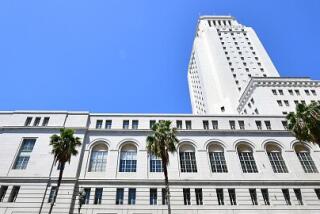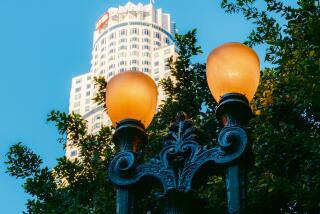Shedding Light on the Complex History of Traffic Signals
- Share via
William Potts never found his way into the history books, but most of us would be lost without him. Or at least stuck somewhere in traffic.
Back in 1920, the Detroit cop erected a box with red, yellow and green lights at the intersection of Woodward Avenue and Fort Street to bring order to the chaotic streets of the Motor City.
About 75 years later, the traffic signal designed by Potts has become the standard by which cities around the world regulate traffic. Despite their apparent simplicity--stop, go, stop, go--traffic signals are among the most technologically advanced pieces of infrastructure most cities operate, relying on sometimes vast computer networks to keep intersections moving smoothly.
And they are everywhere.
In an average day, a motorist in Los Angeles might drive through dozens upon dozens of signals without even thinking. But the powerless hours after last year’s Northridge earthquake demonstrated how dependent cities are on traffic lights. Many intersections were impassable without them.
“It’s a gadget that controls our lives more than any other gadget you can name,” said Peter Parsonson, an engineering professor at the Georgia Institute of Technology in Atlanta.
Just within the city limits of Los Angeles, there were 4,031 intersections controlled by traffic lights in August, 1994, the last month for which figures are available. That translates into 164,899 separate 135-watt bulbs, or an average of 40 bulbs per intersection.
All of these lights make urban designer Stan Eisner wonder if maybe the engineers have gone overboard.
“It’s a visual nightmare,” said Eisner, executive officer for the Ventura County Local Agency Formation Commission. “We need 32 or 64 different lights just to make the damn intersections work. The engineers assume drivers are stupid.”
Eisner reminisced about the simpler days of traffic control, when a town’s automotive ebb and flow were regulated by a single fixture hanging from wires in the middle of the intersection, bobbing in the wind.
Parsonson said such Spartan approaches might work in cow towns, but could be fatal in big cities like Los Angeles, where speeds inch up with time.
“We have excellent reasons” for installing so many lights, Parsonson said. He pointed out that lights burn out from time to time--about every 8,000 hours in Los Angeles. Better, he said, to have at least part of an intersection’s signals working than none at all.
“We’re not just trying to burn up electricity.”
The world’s first primitive traffic light was erected in 1868 at George and Bridge streets near Parliament in London. Adapted from railroad signals, the gas-powered device was put up at the request of members of Parliament, who feared getting squashed by carriages in the busy street.
Common folk were allowed to use the signal, too.
“Its success was phenomenal,” said Thomas Brahms, executive director of the Institute of Traffic Engineers in Washington, taking his information from the group’s less than best-selling tome “Traffic Devices: Historical Aspects Thereof.”
In its early days, though, the London light caused more problems than it solved. It quickly became something of a curiosity as throngs of Londoners came to gawk at the device. Vendors sold snacks and the police often were summoned to keep order.
At one point, two police officers operating the light were killed when it malfunctioned and exploded. “It caused some pain and suffering,” Brahms conceded.
By 1869, the House of Commons took up the issue of dismantling the signal. After a typically British debate, it was decided that the light should not only remain, but that others should be erected citywide. The design, however, was changed and by 1872 the original light at Bridge and George was taken down.
In the United States, there was what Brahms called a “free-for-all” in the field of traffic control. Cleveland residents claim inventor Garrett Morgan designed the first traffic signal, a rotating device patented in 1923.
“He is completely overlooked,” said Diane Sielski, a librarian at the Garrett Morgan Cleveland School of Science. Sielski and some of her students are launching a research project about Morgan and his inventions. During Black History Month, Morgan is often cited as an African American scientist--he also invented the gas mask--whose contributions are overlooked by most historians.
Meanwhile, in Salt Lake City, the man who invented the traffic light is generally believed to be police officer Lester Farnsworth Wire. According to local lore, Wire dipped some old lights in red and green watercolors and placed them in a wooden box to control traffic at Christmas in 1912. Apparently, he thought the colors were festive.
Nobody paid the lights at Main and Second South streets much mind at first, but eventually they caught on around the city. Salt Lake also became the first U.S. city to interconnect and synchronize its signals in 1917.
During the 1920s and 1930s, as automobiles became the vogue, more and more places adopted some form of traffic control, often unique from place to place. In Australia, for instance, officials experimented with a clock-style light in which the rotating arm alternated between stop and go. Some places used countdown lights similar to those at drag strips.
In New York, the city erected ornate traffic towers. Architects competed for the honor of designing the towers, some of which were made of bronze, had solid granite bases and included clocks and bells that chimed at noon and midnight.
In the end, though, it was the simple design of William Potts of Detroit that became the standard--in part because of its simplicity. The three-light design allowed a transition--yellow light--between stop and go that engineers decided was safer than abrupt changes between red and green.
Los Angeles got its first set of lights in 1920, and by 1929 it became the first city in the world to install an on-demand signal for pedestrians. It was at the corner of Figueroa and Meridian streets in front of Luther Burbank Junior High School.
According to an article in a traffic engineering newsletter, the signal’s instructions were simple: “Push Button Wait Your Turn.”
Over time, as signals become standardized worldwide, technology has turned the lights into expensive and complicated pieces of infrastructure. Installing signals at just one intersection can cost between $70,000 and $140,000, according to Los Angeles transportation engineer Brian Gallagher.
Computers control dozens of signals to coordinate intersections across town. Sensors embedded in the street tell lights when to change. Mathematical formulas are also used to determine how long the lights remain a particular color, taking into consideration everything from the speed limit to the grade of the road. And monitors are constantly checking the systems to make sure lights are working properly.
Color experts have been brought in to determine the most effective shades of red, yellow and green. For instance, the green and red of pedestrian crossing signals are slightly different shades than the green and red in a traffic light.
“Don’t walk” signs are “Portland orange.” “Walk” signs are “lunar white.”
More to Read
Sign up for Essential California
The most important California stories and recommendations in your inbox every morning.
You may occasionally receive promotional content from the Los Angeles Times.













